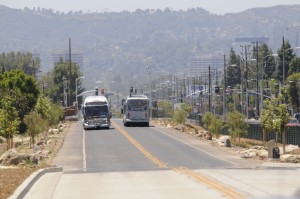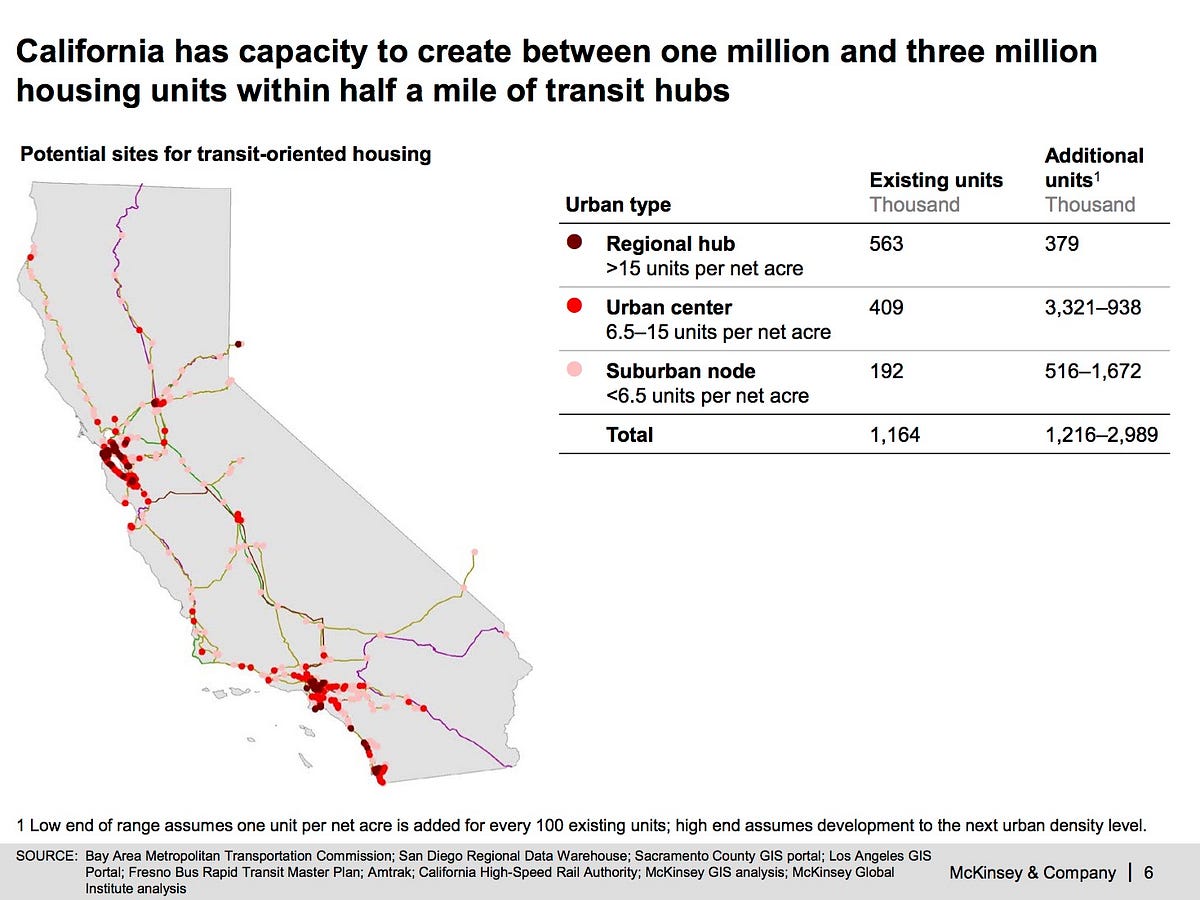If passed as is, SB 827 (Wiener) could have a big impact on neighborhoods adjacent to rail and major bus transit in California by requiring local governments to relax development restrictions there. But simply stating “one-quarter mile” or “one-fourth mile” radius from these stops is not that helpful for most people to visualize where the affected neighborhoods are located, particularly when the bill currently includes some areas with “transit corridors” — and not just transit stops.
Fortunately, a tech-savvy (former Redfin CTO) SB 827 fan with time on his hands developed a very useful interactive map. If you live in California (or interested in what happens here), you can now click on Sasha Aickin‘s map and see how any particular city or county might be affected by the bill.
But perhaps more importantly, regardless of what happens with SB 827 during this legislative process, the map shows the battleground in California where we desperately need more housing to be built. All of the highlighted areas are prime transit-oriented spots, where residents can easily bike or walk to access transit. Study after study shows that development in these areas is what makes or breaks transit ridership.
And for a place like California, with its longstanding housing shortage, it also shows where badly needed new residential development would be most appropriate from an environmental perspective.
Happy viewing!
Scott Wiener’s revolutionary SB 827 proposal to ease local restrictions on transit-oriented development is part of a growing legislative trend to tie development incentives to proximity to major transit stops. These stops are defined to include those with frequent bus service. As a result, some pro-growth advocates worry that NIMBYs will respond by lobbying their transit agencies to decrease bus service in their neighborhoods so developers can’t access these benefits and build more in their area.
But what about the opposite problem, where developers lobby transit agencies to increase bus service, merely to get some of the permit streamlining and density boosts that would follow? The danger is that transit agencies would comply, perhaps as a favor to a politically connected developer, but the project at issue wouldn’t actually be transit-oriented or otherwise justify the increased transit service.
 And a worse situation might involve the transit agency increasing bus service only temporarily to qualify the project for the land use and permitting benefits, and then later reduce the service. The consequence could be a type of “density sprawl” with projects that wouldn’t serve transit (or have transit serve them) and instead increase overall driving miles and pollution.
And a worse situation might involve the transit agency increasing bus service only temporarily to qualify the project for the land use and permitting benefits, and then later reduce the service. The consequence could be a type of “density sprawl” with projects that wouldn’t serve transit (or have transit serve them) and instead increase overall driving miles and pollution.
To be clear, we want to encourage development near major bus stops. And this policy trend of tying incentives to transit proximity started before SB 827. For example, SB 375 (Steinberg, 2008) provides permitting relief through streamlining provisions under the California Environmental Quality Act (CEQA) for projects within 1/2 mile of a major transit stop, including frequent bus stops. Similarly, SB 743 (Steinberg, 2013), also relaxes CEQA’s transportation impact analysis for projects in these areas.
But both possibilities of manipulating bus service either to 1) avoid new development in the right transit-oriented areas or 2) facilitate car-oriented projects in less transit-friendly areas would be bad.
What’s the solution? Transit agencies will need to develop strong and transparent standards governing their decisions about when to expand or retract major bus service (defined as 15 minute peak headways during commute times). Follow-up state legislation could potentially accomplish this outcome by mandating such standards on local transit agencies (something these transit agencies would probably hate). Or transit agencies that don’t already have such policies on the books could adopt such standards on their own, perhaps using some best practice examples from around the state and country.
Right now, I don’t think this kind of transit service manipulation is a serious problem, although I’ve started to hear some anecdotes from local transit agencies. But if SB 827 passes in anything like its current form, it may become an issue that policy makers at either the local or state levels will need to address.
In my excitement over SB 827, the new bill that would dramatically boost badly-needed new housing in job- and transit-rich areas in California, I overlooked one potentially important source of opposition: low-income renters near transit. As I described, the bill would limit local restrictions on height, density and parking near transit. I assumed that these changes would mostly affect relatively affluent single-family home neighborhoods near transit, whose residents and allied elected officials often prevent new housing for reasons ranging from the deplorable (racism) to the understandable (fear of more traffic and related hassles).
But for renters and their advocates in existing low-income neighborhoods near major transit stops, the SB 827 approach raises different fears: eviction through displacement and gentrification. They fear the relaxed local government rules under SB 827 will prompt developers to gobble up their existing low-income buildings, evict the tenants, tear down the structures, and then build market-rate housing for people with much higher-income levels. In short, they see SB 827 putting displacement and gentrification in these transit-rich, low-income communities on steroids.
The fear is legitimate, though I believe potentially overstated, depending on the neighborhood. And it’s also something that can be mitigated, with the right policy approach. First, it’s probably overstated because development in low-income communities is not necessarily held back only by strict local zoning. For example, as UCLA scholars Anastasia Loukaitou-Sideris and Tridib Banerjee described in a report examining neighborhoods around the Blue Line light rail from Downtown Los Angeles to Long Beach, low-income areas near the station stops have received virtually no investment in real estate despite sometimes very relaxed local zoning.
The problem in many of these neighborhoods is that demand is not sufficient to attract developers and capital needed to build multistory buildings. These relatively expensive structures must net high rents to justify the higher construction costs. Compounding matters, many low-income neighborhoods often require significant infrastructure upgrades to accompany any new buildings. All of these factors deter developers from investing — not the local zoning codes. Ultimately, capital will flow to the areas that promise the highest return: which means relatively affluent neighborhoods near transit will see the most construction under the SB 827 approach.
Still, those economic dynamics probably won’t by themselves allay the fears of low-income renters and their advocates. Many of the neighborhoods they care about are at risk of gentrification, which means rents could increase, higher-income residents would move in with new construction, and low-income renters forced out.
So what can be done in these situations? There’s a rich literature on the subject, but one of the best ways to mitigate these impacts is to ensure a percentage of the new homes built are available exclusively to people with low incomes. Furthermore, local residents who have been displaced or are at risk of displacement should have priority access to these new homes.
The state already has policies on the books to encourage this type of affordable housing construction, from a now-stricter regional housing needs process (which requires locals to plan and zone for affordable housing in their jurisdiction) to density bonuses for projects that incorporate more affordable units. Local governments are also free to enact their own additional policies to boost affordable housing.
These and other policies may not help all tenants facing displacement, but they would go a long way toward helping many of them — and providing access to better homes for many of them in the process. And overall, new housing near transit will benefit residents of all income levels, including low-income. It will stabilize home prices to allow more residents to live near jobs and save on transportation costs from avoiding long commutes. It will improve public health by reducing regional driving miles. It will provide high-wage construction jobs. It will reduce economic inequality and lack of access to good jobs. And it will unlock the housing that future generations will need to be able to remain in their home communities.
Ultimately, we know we need new housing in California — and lots of it to make up for decades of shortfalls. We should have policies in place to ensure low-income renters gain from this construction. But if we don’t build these homes near our transit- and job-rich areas, then where are we going to build them? SB 827 provides the clearest solution to this decades-long problem in the making. But policy makers should take care to address the concerns of low-income renters who might otherwise stand to lose under this otherwise badly needed legislation.
 As I blogged yesterday, the proposed SB 827 is the first truly revolutionary approach to boosting housing in the most environmentally and economically friendly places in California.
As I blogged yesterday, the proposed SB 827 is the first truly revolutionary approach to boosting housing in the most environmentally and economically friendly places in California.
And this morning on Southern California’s KPCC radio program Airtalk, I discussed the bill with host Larry Mantle, Los Angeles City Councilmember Paul Koretz (5th District), and Mark Ryavec, president of the Venice Stakeholders Association.
The 30-minute discussion surfaced most of the predictable yet flawed objections to the bill, typically raised by homeowners and their allies:
- These new residents in housing near transit won’t really ride the transit, they’ll just add to the local congestion. Mostly false: proximity to transit is a major determinant of how likely people are to ride it. However, it is true that lower-income residents are more likely to ride. But even locating middle-income residents near transit is still better than locating them far out of the city, where they’d have long drives leading to more overall traffic and pollution, or encouraging them to gentrify existing neighborhoods due to the lack of new housing supply. And as we’ve seen in urban areas like the San Francisco Bay Area and Washington DC, professionals will ride transit if it’s convenient to their work.
- New housing near transit will only add to parking and traffic congestion in my neighborhood. Yes, possibly in the immediate areas. But if the new developments don’t oversupply and under-price parking (and SB 827 relaxes minimum parking requirements) and instead offer better transit, walking and biking access, people will be more likely to choose to avoid the traffic. And overall traffic across the region will decrease with more in-town housing, which means less pollution and regional congestion for everyone. Otherwise, the alternative is more sprawl housing.
- Transit isn’t functional in L.A. right now, so there’s no need to build more housing near it. This is to some extent a circular argument. If there’s not sufficient housing (or other development) near transit, then as a result it won’t serve many of the places people want to go. Only by encouraging that development near rail and other high-quality transit — as opposed to waiting decades for rail to go to the right places — can the system be successful. We see this all around the world with well-functioning transit lines.
The discussion and listener comments are worth hearing, because they track the typical objections to the bill’s proposals. As I wrote yesterday, SB 827 will be a huge political effort. But at the same time, it presents an opportunity to discuss the facts with the persuadable part of the electorate.
California State Senator Scott Wiener just introduced the bill I’ve probably been waiting for since I started following land use and transit in California. SB 827 would dramatically scale back local government restrictions on housing near major transit stops (see the fact sheet PDF).
These restrictions by local governments have prevented new housing from being built in precisely the job- and transit-rich locations where we need housing the most. They’ve also prevented transit from performing well, in terms of greater ridership and reduced public subsidies, as light rail lines like Expo in Los Angeles serve neighborhoods that don’t allow anything but a single-family, detached home to be built.
Overall, the effect on housing supply from these exclusionary zoning policies has caused severe environmental degradation in the state by encouraging more sprawl and traffic. And it’s caused an economic crisis of unaffordable homes and rents that has squeezed the middle class right out of the state and led to gentrification of low-income neighborhoods.
SB 827 puts a bullseye on these policies. First, among other reforms, it would remove all density limits and parking requirements on any project within a half-mile of a major transit station, defined as anything from rail to a bus stop with at least 15 minute intervals during peak commute times.
As if these changes aren’t enough, SB 827 would prevent local governments from imposing a height limit of less than 85 feet if the development is within one-quarter mile of a “high-quality transit corridor” or within one block of a major transit stop (with a few exceptions), and 55 feet if within a half-mile.
As Sen. Wiener explained in a Medium post:
California has a number of communities with strong access to transit, and we continue to invest in public transportation. Too often, however, the areas around transit lines and stops are zoned at very low densities, even limiting housing to single family homes around major transit hubs like BART, Caltrain, Muni, and LA Metro stations.
Mandating low-density housing around transit make no sense.
Sen. Wiener went on to cite a recent California analysis by the consulting firm McKinsey, which concluded that California could build up to three million new transit-accessible homes in these transit-rich areas:

Along these lines, our analysis at CLEE and UC Berkeley’s Terner Center in the 2017 report Right Type, Right Place found that California could achieve annual greenhouse gas reductions of 1.79 million metric tons if we built all new residential development within a few miles of major transit (not to mention additional savings if you factor in new commercial development in those areas plus reduced driving and pollution from existing residents there).
California has attempted to address this environmental and economic challenge from the multi-decade long underproduction of housing legislatively over the past few years. But most of those bills have been largely ineffectual reforms to planning or way-too-limited streamlining that only adds up to a drop in the bucket. Meanwhile, even relatively robust efforts to subsidize affordable housing are miniscule compared to the scope of the problem. SB 827 is the first one that could really, truly be a game-changer for housing and the environment.
To be sure, SB 827 faces an uphill battle to passage. Wealthy homeowners in single-family neighborhoods, along with their elected representatives and lobbyists, will be out in full force to defeat this bill. They may even have help from advocates of subsidized affordable housing, who often rely on processes to relax these exclusionary local policies as a way to gain concessions to build more affordable units. The parking requirement relaxation provision alone was already attempted back in 2011 as a standalone bill and went down to defeat in the legislature at the hands of the League of California Cities.
But on the upside, the politics in Sacramento around housing have changed in the past few years, as the scale of the problem has become more clear and as constituent groups like the “YIMBYs” have been organizing politically. That means that the bill may eventually survive to passage, albeit in a potentially stripped-down form.
If it goes down to defeat, it will be interesting to see how much support it gets. Because this issue isn’t going away, and neither are pro-housing advocates. They’ll keep coming back until California starts to take steps to address decades of terrible land use policies.
SB 827, as introduced, is the first truly significant step in that direction.


